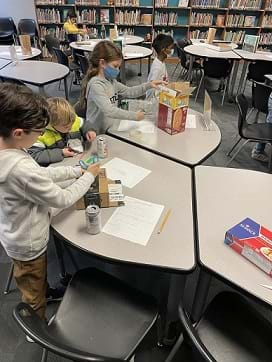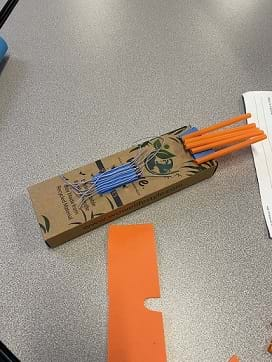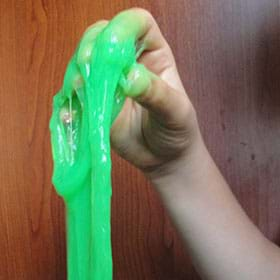
Summary
Students use recyclable materials to make musical instruments. Students learn the different states of matter and that matter has properties. They observe and classify recycled materials by size, color, material and any other property the students feel is important. As they observe the materials, students decide which materials would work best for instruments. Students use the engineering design process to create and build an instrument. Working with a small group, they collaborate, ask, imagine, plan, create, and test their instrument. As time allows, they also improve their instrument by thinking about what materials can be added or taken away to make their instrument sound and work better.Engineering Connection
Scientists look at the physical properties of materials (matter) to classify them and determine their best use or purpose. Engineers use these materials to invent, design, and maintain a variety of materials and structures. Engineers use the engineering design process to create and make improvements in order to arrive at their end product. Determining the most suitable material for a project can mean the difference between success and failure.
Learning Objectives
After this activity, students should be able to:
- Describe the physical characteristics of matter.
- Sort matter into like groups based on their properties.
- Work through the engineering design process.
- Determine which materials work best for different instruments based on their properties.
Educational Standards
Each TeachEngineering lesson or activity is correlated to one or more K-12 science,
technology, engineering or math (STEM) educational standards.
All 100,000+ K-12 STEM standards covered in TeachEngineering are collected, maintained and packaged by the Achievement Standards Network (ASN),
a project of D2L (www.achievementstandards.org).
In the ASN, standards are hierarchically structured: first by source; e.g., by state; within source by type; e.g., science or mathematics;
within type by subtype, then by grade, etc.
Each TeachEngineering lesson or activity is correlated to one or more K-12 science, technology, engineering or math (STEM) educational standards.
All 100,000+ K-12 STEM standards covered in TeachEngineering are collected, maintained and packaged by the Achievement Standards Network (ASN), a project of D2L (www.achievementstandards.org).
In the ASN, standards are hierarchically structured: first by source; e.g., by state; within source by type; e.g., science or mathematics; within type by subtype, then by grade, etc.
NGSS: Next Generation Science Standards - Science
| NGSS Performance Expectation | ||
|---|---|---|
|
2-PS1-1. Plan and conduct an investigation to describe and classify different kinds of materials by their observable properties. (Grade 2) Do you agree with this alignment? |
||
| Click to view other curriculum aligned to this Performance Expectation | ||
| This activity focuses on the following Three Dimensional Learning aspects of NGSS: | ||
| Science & Engineering Practices | Disciplinary Core Ideas | Crosscutting Concepts |
| Plan and conduct an investigation collaboratively to produce data to serve as the basis for evidence to answer a question. Alignment agreement: | Different kinds of matter exist and many of them can be either solid or liquid, depending on temperature. Matter can be described and classified by its observable properties. Alignment agreement: | Patterns in the natural and human designed world can be observed. Alignment agreement: |
| NGSS Performance Expectation | ||
|---|---|---|
|
2-PS1-2. Analyze data obtained from testing different materials to determine which materials have the properties that are best suited for an intended purpose. (Grade 2) Do you agree with this alignment? |
||
| Click to view other curriculum aligned to this Performance Expectation | ||
| This activity focuses on the following Three Dimensional Learning aspects of NGSS: | ||
| Science & Engineering Practices | Disciplinary Core Ideas | Crosscutting Concepts |
| Analyze data from tests of an object or tool to determine if it works as intended. Alignment agreement: | Different properties are suited to different purposes. Alignment agreement: | Simple tests can be designed to gather evidence to support or refute student ideas about causes. Alignment agreement: Every human-made product is designed by applying some knowledge of the natural world and is built using materials derived from the natural world.Alignment agreement: |
| NGSS Performance Expectation | ||
|---|---|---|
|
2-PS1-3. Make observations to construct an evidence-based account of how an object made of a small set of pieces can be disassembled and made into a new object. (Grade 2) Do you agree with this alignment? |
||
| Click to view other curriculum aligned to this Performance Expectation | ||
| This activity focuses on the following Three Dimensional Learning aspects of NGSS: | ||
| Science & Engineering Practices | Disciplinary Core Ideas | Crosscutting Concepts |
| Make observations (firsthand or from media) to construct an evidence-based account for natural phenomena. Alignment agreement: | Different properties are suited to different purposes. Alignment agreement: A great variety of objects can be built up from a small set of pieces.Alignment agreement: | Objects may break into smaller pieces and be put together into larger pieces, or change shapes. Alignment agreement: |
State Standards
Texas - Science
-
combine materials that when put together can do things that they cannot do by themselves such as building a tower or a bridge and justify the selection of those materials based on their physical properties.
(Grade
2)
More Details
Do you agree with this alignment?
-
demonstrate that things can be done to materials to change their physical properties such as cutting, folding, sanding, and melting; and
(Grade
2)
More Details
Do you agree with this alignment?
-
classify matter by physical properties, including shape, relative mass, relative temperature, texture, flexibility, and whether material is a solid or liquid;
(Grade
2)
More Details
Do you agree with this alignment?
Materials List
Each group needs:
- recycled materials, such as cardboard boxes and tubes, string, plastic bottles and containers, bottle caps
- tape
- scissors
- rubber bands
- small items (10-15 per group) that students can sort such as pipe cleaners, papers, marbles, craft sticks, erasers
- paper bag (to hold the small items)
- Describing Properties Student Worksheet, EDP Student Worksheet, Idea Chart Worksheet
For the teacher
- copy of Ada’s Violin (available on Amazon) or the Ada's Violin Read Aloud on YouTube
For the entire class to share:
- poster paper
- cardboard
- magic markers
- crayons
- craft sticks
- string
Worksheets and Attachments
Visit [www.teachengineering.org/activities/view/uot-2693-musical-instruments-design-material-properties] to print or download.Introduction/Motivation
Did you know recycled materials can be altered or changed in some way to create sound? There are many countries where students do not have the money to purchase instruments for school or individual use. A solution that the students in Paraguay discovered was to take recycled materials and change them in different ways to make instruments. Once they decide which instrument they would like to make, they have to make some decisions. Which material would work best for that instrument? What parts will I take away or add to make my instrument work? These are decisions that engineers make when they are working on a project. Engineers test and study different materials to decide which material will work best for an item and be the most reliable.
In this activity, we are going to observe materials and classify them. We will determine what these materials have in common and decide how we could put them into groups that have similar properties.
We are then going to look at some different items and determine which ones we think work best for certain instruments and why. Is it the material that makes the difference? Is it the changes we make to the material? Is it because we added items to another item to make a change that would produce sound?
After we have sorted our materials and discovered their properties, we are going to be planning and constructing an instrument for our team. We will be following the Engineering Design Process to complete our instrument. You will brainstorm, plan, give feedback and revise your plan before completing the instrument.
Procedure
Background
Matter is anything that has mass and takes up spaces. The clouds, the ocean, and the trees, it's all matter! There are three different states of matter: solid, liquid and gas. These states of matter have properties. Observable properties include color, flexibility, hardness, texture, and absorbency. Properties of small objects do not change when the pieces are combined with other objects.
If students need a refresher on matter, ask them these questions and discuss as a class:
- How does the shape of things help it do what it was made to do?
- How does the color of things help it do what it was made to do?
- Texture is used to describe how something feels. What words can be used to describe the texture of a material?
- How does the texture of a material help it do what it was made to do?
- What are other properties of matter? Why are they important?
Engineers use a model called the engineering design process to guide them through any project. We will be using this process to make our instruments.
Before the Activity
- Gather recycled materials. Start collecting recycled materials at least a month before the project; reach out to your community!

Ideas of what you can use for instruments - Gather various small items (e.g., pipe cleaners, paper, marbles, craft sticks, erasers), enough for each group to have 10-15 items. Place each group’s items into paper bags.
- Make copies of the Describing Properties Student Worksheet, EDP Student Worksheet, Idea Chart Worksheet.
- Get a copy of Ada’s Violin (available on Amazon) or the Ada's Violin Read Aloud on YouTube.
With the Students
Day 1
- Read Ada’s Violin (or Ada's Violin Read Aloud on YouTube) and show YouTube videos of Recycled Orchestra - https://www.youtube.com/watch?v=yYbORpgSmjg.
- Review prior knowledge of matter, properties of matter and ways to sort/classify matter.
- Divide students into groups of three.
Day 2
- Create a chart with descriptive words.
- Give students a paper bag with different, small items in it. They will observe the physical features of the items and record their findings on their Describing Properties Student Worksheet.
- Students will then sort their items in any way and will explain why they grouped those items together—what feature did they have in common?
- Have students re-sort their items by different physical characteristics by material type, size, and purpose.
- Then ask the question, “If you were told that you would be making an instrument out of these materials, would you change the way you sorted them?”
- Let students re-sort their items based on new information.
- Have students observe and record findings.
Day 3
- Introduce the engineering design process and talk through all the steps. Distribute the EDP Student Worksheet.
- Have a table with all the recycled materials on it that the students will have access to and additional supplies.
- Let students in each group start planning, designing, and collaborating.
- Remind students that they are restricted by time and materials, so they need to take that into account.
- Check that students are filling out the “Ask,” “Imagine,” and “Plan” sections of the EDP Student Worksheet.
Day 4
- Tell students that now it is time to create their designs!
- They will use this time to gather their materials and construct their instruments. Remind students to refer to the plans they made on the EDP Student Worksheet to guide them.
- Students need to use caution when cutting materials as some items may be sharp; walk around and help students as needed.




Day 5
- Tell students that it is time to perform!
- Students will present their instrument, demonstrate how it works and share their process.
- If time allows, students can revise their plan, consider the advice, and improve their instrument. They will fill out the “Test” and “Improve” sections of the EDP Student Worksheet.
Vocabulary/Definitions
classify: To place items into different categories based on their features/properties.
matter: Anything that takes up space is call matter.
property: A characteristic of an object that can be observed, such as its size, shape, color or material.
solid: A type of matter that keeps its shape and has a definite volume.
Assessment
Pre-Activity Assessment
Idea Chart: Draw the idea chart on the board. Have students use the Idea Chart Worksheet and share out.
Have students brainstorm words that they could use to describe a solid. Create an anchor chart for these words.
Datasheet: Have students use the Describing Properties Student Worksheet to record the properties of the items at their table.
Think and Sort: Have students identify some other characteristics of the items. Let them sort the items in any way they want. Listen to conversations.
Activity Embedded (Formative) Assessment
Handout: Have students work together to fill out the EDP Student Worksheet of the design process
Post-Activity (Summative) Assessment
Demonstrate their instrument. Complete the last two steps of the design process.
Making Sense Assessment: Have students reflect on the science concepts they explored and/or the science and engineering skills they used by completing the Making Sense Assessment.
Safety Issues
- Use caution with using scissors.
- Be aware of sharp edges on metals, plastics and cardboard.
Activity Extensions
- Take pictures of the instruments and recordings of students playing them and send them to the head of the Recycled Orchestra.
- Create a YouTube channel.
- Brainstorm other uses for recycled materials to reduce pollution.
Activity Scaling
- For younger students- the activity could include just the properties of matter and sorting of materials by properties.
- For older students- concepts of sound energy, conservation and financial literacy could be taught.
Additional Multimedia Support
- YouTube link about Recycled Orchestra, https://www.youtube.com/watch?v=yYbORpgSmjg
- Ada's Violin Read Aloud on YouTube, https://www.youtube.com/watch?v=E3A85bWecwg
Subscribe
Get the inside scoop on all things TeachEngineering such as new site features, curriculum updates, video releases, and more by signing up for our newsletter!More Curriculum Like This

Students are introduced to chemical engineering and learn about its many different applications. An associated hands-on activity gives students a chance to test their knowledge of the states of matter and how to make observations using their five senses: touch, smell, sound, sight and taste.

An exploration of an engineering brief from a mock toy company leads students to explore a new slime with a unique set of characteristics. Using simple directions, students create five different types of slime and classify their slime properties against the criteria provided by the mock toy company....

Learn the basics of the analysis of forces engineers perform at the truss joints to calculate the strength of a truss bridge known as the “method of joints.” Find the tensions and compressions to solve systems of linear equations where the size depends on the number of elements and nodes in the trus...
Copyright
© 2023 by Regents of the University of Colorado; original © 2022 University of Texas at AustinContributors
Catherine Jones, Melissa Saldana, Risa Hartman, Emily Brady, Diana Garcia, Dr. Eric TaleffSupporting Program
2021 NASCENT Research Experience for Teachers (RET), Department of Mechanical Engineering, University of Texas at AustinAcknowledgements
This material is based upon work supported by the National Science Foundation under grant no. EEC-1160494—a Research Experience for Teachers program titled “Nanomanufacturing Systems for Mobile Computing and Mobile Energy Technologies, or NASCENT.” Any opinions, findings and conclusions or recommendations expressed in this material are those of the author(s) and do not necessarily reflect the views of the National Science Foundation.
Last modified: March 16, 2023










User Comments & Tips